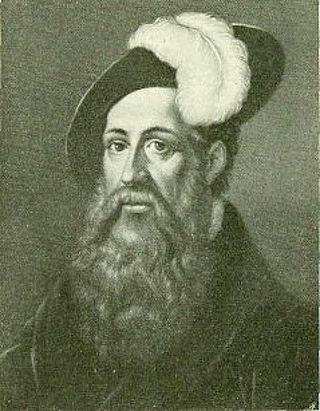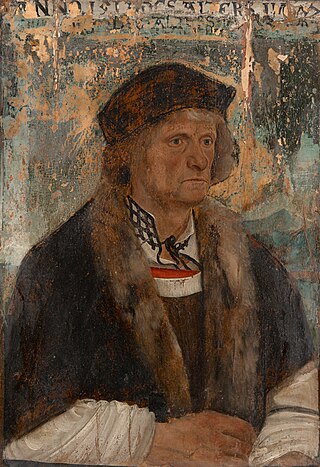
Johannes Gensfleisch zur Laden zum Gutenberg was a German inventor and craftsman who introduced letterpress printing to Europe with his movable-type printing press. Though not the first of its kind, earlier designs were restricted to East Asia, and Gutenberg's version was the first to spread across the world. His work led to an information revolution and the unprecedented mass-spread of literature throughout Europe. It also had a direct impact on the development of the Renaissance, Reformation and humanist movement.

Johann Fust or Faust was an early German printer.

NicholasJenson was a French engraver, pioneer, printer and type designer who carried out most of his work in Venice, Italy. Jenson acted as Master of the French Royal Mint at Tours and is credited with being the creator of one of the finest early Roman typefaces. Nicholas Jenson has been something of an iconic figure among students of early printing since the nineteenth century when the artist William Morris praised the beauty and perfection of his roman font. Jenson is an important figure in the early history of printing and a pivotal force in the emergence of Venice as one of the first great centers of the printing press.

Johann Amerbach was a celebrated printer in Basel in the 15th century. He was the first printer in Basel to use the Roman type instead of Gothic and Italian and spared no expense in his art.

Johann Froben, in Latin: Johannes Frobenius, was a famous printer, publisher and learned Renaissance humanist in Basel. He was a close friend of Erasmus and cooperated closely with Hans Holbein the Younger. He made Basel one of the world's leading centres of the book trade. He passed his printing business on to his son, Hieronymus, and grandson, Ambrosius Frobenius.

The German Renaissance, part of the Northern Renaissance, was a cultural and artistic movement that spread among German thinkers in the 15th and 16th centuries, which developed from the Italian Renaissance. Many areas of the arts and sciences were influenced, notably by the spread of Renaissance humanism to the various German states and principalities. There were many advances made in the fields of architecture, the arts, and the sciences. Germany produced two developments that were to dominate the 16th century all over Europe: printing and the Protestant Reformation.

Modern typographers view typography as a craft with a very long history tracing its origins back to the first punches and dies used to make seals and coinage currency in ancient times. The basic elements of typography are at least as old as civilization and the earliest writing systems—a series of key developments that were eventually drawn together into one systematic craft. While woodblock printing and movable type had precedents in East Asia, typography in the Western world developed after the invention of the printing press by Johannes Gutenberg in the mid-15th century. The initial spread of printing throughout Germany and Italy led to the enduring legacy and continued use of blackletter, roman, and italic types.

Arnold Pannartz and Conrad Sweynheym were two printers of the 15th century, associated with Johannes Gutenberg and the use of his invention, the mechanical movable-type printing press.
The brothers Johann and Wendelin of Speyer were German printers in Venice from 1468 to 1477.

Johannes Mentelin, sometimes also spelled Mentlin, was a pioneering German book printer and bookseller active during the period during which incunabula were printed. In 1466, he published the first printed Bible in the German language, the Mentelin Bible.

The Giunti were a Florentine family of printers. The first Giunti press was established in Venice by Lucantonio Giunti, who began printing under his own name in 1489. The press of his brother Filippo Giunti (1450–1517) in Florence, active from 1497, was a leading printing firm in that city from the turn of the sixteenth century. Some thirty members of the family became printers or booksellers. A press was established in Lyon in 1520. By about 1550 there were Giunti bookshops or warehouses in Antwerp, Burgos, Frankfurt, Lisbon, Medina del Campo, Paris, Salamanca and Zaragoza, and agencies in numerous cities of the Italian peninsula, including Bologna, Brescia, Genoa, Livorno, Lucca, Naples, Piacenza, Pisa, Siena and Turin, as well as the islands of Sardinia and Sicily.

Heinrich Gran was a German book printer of the incunabular era. Together with Johannes Mentelin and Heinrich Eggestein, he was one of the pioneers of book-printing in Alsace.

Hieronymus Vietor was a printer and publisher born in Silesia and active in Vienna and Kraków. Famous for the quality and quantity of his prints, he is considered one of the most important early book printers in Poland, also because he was the first to regularly print in Polish. He is also known as Hieronymus Philovallensis or Hieronymus Doliarius, or in Polish as Hieronim Wietor or Büttner.

Günther Zainer was the first printer in Augsburg, where he worked from 1468 until his death; he produced about 80 books including two German editions of the Bible and the first printed calendar. He came to Augsburg from Strassburg and printed in 1472–76 three large works of moral instruction. He also printed the first large illustrated book, Jacobus de Voragine's Legenda aurea in 2 volumes with 131 woodcuts, 1471–76. Johann Zainer, the first printer in Ulm, was probably his brother.
Adolf Rusch von Ingweiler was a notable German printer and publisher. He was the first printer north of the Alps to print in Antiqua.

Lucantonio Giunti or Giunta was a Florentine book publisher and printer, active in Venice from 1489, a member of the Giunti family of printers. His publishing business was successful, and among the most important in the late fifteenth and early sixteenth centuries. Through partnerships, often with members of his family, he expanded the business through much of Europe. At about the time of his death in 1538 there were Giunti presses in Florence and Lyon, Giunti bookshops or warehouses in Antwerp, Burgos, Frankfurt, Lisbon, Medina del Campo, Paris, Salamanca and Zaragoza, and agencies in numerous cities of the Italian peninsula, including Bologna, Brescia, Genoa, Livorno, Lucca, Naples, Piacenza, Pisa, Rome, Siena and Turin, as well as the islands of Sardinia and Sicily.

Matteo Capcasa was a printer and typographer from Parma, in Emilia in central Italy, which at that time was subject to the Duchy of Milan. He was active as a book printer and typographer in Venice from 1485, when he printed a Vocabularium utriusque iuris and an anonymous Fior di virtù. His workshop was in San Paterniano, where he worked with his brother Giovanni.

Johannes Engel, also known as Johannes Angelus, was a doctor, astronomer and astrologer from Aichach, near Augsburg, which at that time was a Free Imperial City within the Holy Roman Empire. He practiced medicine in Vienna, and published numerous almanachs, planetary tables and calendars. His Astrolabium planum was published by Erhard Ratdolt of Augsburg in 1488; a second edition was printed by Johann Emerich for Lucantonio Giunti in Venice in 1494.

Giovanni Battista Ciotti, or Ciotto, was an Italian publisher and typographer.
Johannes Petri a printer in Basel and the founder of the oldest existing publishing house in 1488.
















